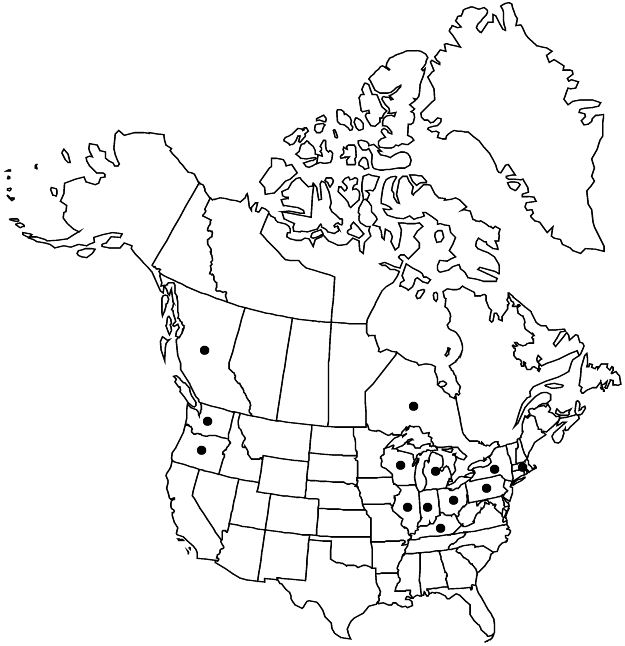Cotoneaster divaricatus
in C. S. Sargent, Pl. Wilson. 1: 157. 1912.
Shrubs, 1.5–2 m; crown spreading, rounded. Stems erect; branches divaricate or spiraled, spreading, lateral branches well developed, usually arching, long, brownish violet, initially strigose. Leaves deciduous; petiole 3–4 mm, strigose; blade elliptic, rarely ovate or suborbiculate, on sterile shoots usually elliptic or broadly elliptic, 10–30 × 7–21 mm, chartaceous, base obtuse, margins flat, not revolute, sometimes undulate, veins 3 or 4, superficial or slightly sunken, apex acute, rarely acuminate, abaxial surfaces pale green, initially strigose, adaxial dark green, shiny, not glaucous, flat between lateral-veins, initially sparsely strigose; fall leaves orange, red, or reddish purple. Inflorescences on fertile shoots 10–20 mm with 4 leaves, 1–4-flowered, compact. Pedicels 1–3 mm, strigose. Flowers 6–8 mm, opening small; hypanthium cupulate, strigose; sepals: margins villous, apex acute or acuminate, surfaces strigose; petals erect-incurved, pale-red, base dark red, border white; stamens 10–15, filaments dark red, whitish distally, anthers white; styles (1 or) 2 (or 3). Pomes dark red to ruby (finally blackish red), cylindric, oblong-ellipsoid, or narrowly obovoid, 8–11 × 4–8 mm, shiny, not glaucous, sparsely pilose; sepals suberect, sparsely pilose; navel open; style remnants 2/3 from base. Pyrenes (1 or) 2 (or 3) [rarely 4].
Phenology: Flowering Apr–May; fruiting Sep–Dec.
Habitat: Thickets, edges, disturbed forests, flood plains, rarely epiphytic on maple
Elevation: 0–700 m
Distribution

Introduced; B.C., Ont., Ill., Ind., Ky., Mass., Mich., N.Y., Ohio, Oreg., Pa., Wash., Wis., Asia (China), also in Europe
Discussion
Although rarely collected, Cotoneaster divaricatus is the most widely escaped cotoneaster in eastern North America. Misidentified specimens of it have been reported from New York as C. hupehensis Rehder & E. H. Wilson (R. S. Mitchell and G. C. Tucker 1997), from Illinois as C. acutifolius (J. T. Kartesz and C. A. Meacham 2003), from Indiana and Ontario as C. horizontalis (Kartesz and Meacham), from Kentucky as C. apiculatus Rehder & E. H. Wilson (Kartesz and Meacham), and from Wisconsin as C. lucidus (Kartesz and Meacham).
Selected References
None.
Lower Taxa
"dm" is not declared as a valid unit of measurement for this property.
